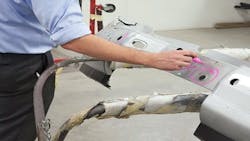
“We cannot solve our problems with the same thinking we used when we created them,” said Albert Einstein. It’s interesting how some days while driving home, shop owners and managers feel like all they did all day was put out fires. If this is true for any of us, we need to realize there is a better way. Our all-consuming goal should be to create a culture of “long-term mutual prosperity for everyone!” If we can accomplish this, we can pay our people more than anyone in our market, enjoy profits we never imagined, repair cars with more efficiency and quality, and take market share. This is only done by having systems in place to make the work easier and more fun.
Outside of collecting total-loss fees, we only get paid to complete lines items on our estimates. For the next three months, I am going to focus on the most crucial stage of waste elimination inside of today’s collision repair shops.
For the folks who have been in collision repair for, say, less than 10 years, there was an ocean wave called “lean” that rolled through our industry from roughly 2005-2014. Lean is about creating more value with less effort and resources. Many buzzwords at that time were floating around, like kaizen, kanban, continuous improvement, 5S, and so on. Lean is a very high road level of thinking, but sadly it can be hard to find in most traditional North American body shops today. Fortunately, there is just a one-word exception that we still hear in quite a few shops from the Lean movement and that word is “Blueprinting.”
If we had a thesaurus for collision repair, here could be some blueprinting synonyms: repair planning, damage analysis, 100% disassembly, teardown, and more. So, what is blueprinting? Well, as my friend Steve Trapp, formerly of Axalta and now Leap Consulting (and FenderBender contributor) has so accurately defined: “Blueprinting is the question mark-removal department; all questions are answered right here!” “What kind of questions?” you ask. Well, have we made all our repair vs. replace and blend/no blend decisions? Have we researched all OEM procedures, inspections, and one-time-use parts? Have we discovered ALL the damage? At the end of the blueprint, have we ordered every part we need? The goal of a complete blueprint is to make only one parts order, have a thoroughly written repair plan, no supplements beyond this point, and for the vehicle to never stop once production has started. For some, this may sound like a fairytale, but this is the cornerstone to a culture of rewarding work for our employees, customers who leave as raving fans, and cash to share with all!
I went out-of-state months back to visit a shop and view their processes. Prior to my visit, this shop had told me they had a blueprint process. When I entered their “Blueprint Dept.,” there was a job that needed a rear body panel replacement. The only parts removed were the rear cover and a couple trunk interior pieces. Near the car was a pile of new parts still in boxes, and the car was headed for production that day! This job was DOOMED to have no chance of having all the parts on order and running non-stop through production. The estimate was also likely missing 40-50 labor operations or would have to stop during production four to five times for supplements. I was literally sick to my stomach. I asked a few questions about the vehicles’ current state, and I received a broad-brush answer back, “There won’t be any problems downstream.” The good book says it best: “Pride goes before destruction, a haughty spirit before a fall.”
For those who have cameras inside their shops, I want to challenge you to watch the shop floor for an entire day at 8X for one hour. Many shops will find the actual technician touch time on a vehicle is very limited and at best, probably less than two to three clock hours per day. I am talking hands on the car (removing, straightening, sanding, priming, bagging, spraying, installing, and washing). By studying the video, here are the wasteful things that we will likely see our people doing: Looking for paperwork, finding keys, discussions between departments, moving cars, creating additional supplements, repriming, do we fix the dent in the blend panel, digging through parts carts, sifting through hardware, finding wrong fasteners, missing a bracket, etc. to infinity! Remember, the problem 99 percent of the time is NOT our people, but rather the system we have forced them to work in.
Look for February’s column as we dive into the nuts and bolts of what a proper blueprint should look like. This will include how to check in a vehicle, parts carts, blueprint teams, OEM procedures, proper dismantle, and more.